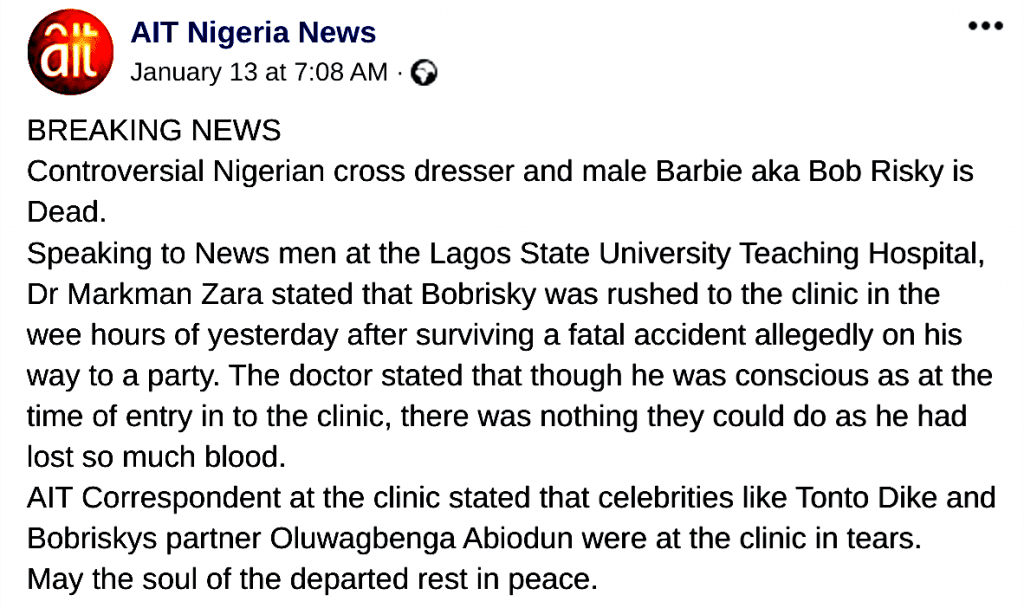The Recent Bobrisky Drama Uncovers Another Interesting Level Of Fake News

Fake news is no longer a new topic anywhere. But if we are to keep a keen eye on developments nowadays, we’d understand that perpetrators are starting to use new methods. The conundrum about the death of a Nigerian Snapchat celebrity, Bobrisky, if anything, either brings the tact to light or reemphasizes its menace.
Bobrisky ‘Dead’
At the beginning of the week, a news portal broke that the Nigerian crossdresser and social media sensation, Idris Okunye, popularly known as Bobrisky, was dead.
The fake news was peddled by a Facebook page who many, at the time, believed to belong to African Independent Television (AIT). The report which took social media by a grip said the transvestite passed on at the Lagos State University Teaching Hospital (LUTH), after a fatal car crash the previous night.
The “fake news” appears to have been fairly convincing. Both fans and critics made social media, especially Twitter, agog.
It was somewhat easy for most people to believe because the story was reportedly carried by the operator of Free To Air in Nigeria – one of the largest privately operated terrestrial television networks. AIT has stations in twenty-four out of thirty-six states in Nigeria, so it was assumed that professional journalism would be a given.
Other news portals who carried the news referred to AIT as their source, which made the situation even more complicated. With the damage caused by fake news in Nigeria and Africa over the years, it is expected that an organization such as AIT would verify news before publishing.
But Not So Much
It was barely a few hours earlier before the news broke that Bobrisky posted a photo on Instagram. Supposedly coming across the reports of his demise, the closet queen took to social media to discredit the news using rather strong words.
While all fingers pointed to AIT for pushing unverified information, the real truth of the matter appears to have surfaced.
Well, African Independent Television has an official Facebook page with 486 K likes. AIT News Nigeria, who broke the Bobrisky news, has 68K likes, which is a little below bar if considered in many terms.

More interestingly, this second news portal has not taken the post down even after the crossdresser himself debunked it. It is expected of a professional media house like AIT to have done so, on any platform possible.
Also, the official AIT seems to either missed the drama or intentionally paid it deaf ears – perhaps because they absolutely have nothing to do with it. At the time of reporting, the fake remains live on the page, even after all the kerfuffle.
Since no official publication was made by ‘the real’ AIT, then there is hardly any way to associate them with the matter. So, thanks to social media for making the news go viral. In this case, Nigeria’s well-criticized social media bill comes to mind.
Here, there is a strong case of impersonation. The fake news carrier caused an uproar which AIT had to inadvertently absorb. It’s not everyday that such a popular media house would stay quiet about such things.
The Point Is?

A professional view on the matter decries, at the same time, unprofessional journalism and impersonation. Emmanuel Ujiadughele, a news correspondent at Rave 917 FM in Osogbo, Osun State, iterated in an exclusive with WeeTracker, that many media houses are quick to publish without checking their veracity and authenticity.
“No matter how many justifications we put forward, it is both unethical and unprofessional. It is borne out of the desire to be mischievous and drive traffic.
You may want to call it sensationalism but when the news is false, then it borders on mischief. My station has the philosophy of breaking news first but sometimes, we break the news about an hour later because we want to be very sure”.
Emmanuel pleads a compelling case, especially for the other media houses who carried the news with AIT citation. If they had at least checked the activity on Bobrisky’s page or made relevant contact, they would not have been misled.
But again, everyone is supposed to trust AIT, only that this time the media house seems to have nothing to do with it. Noticeably, leading publications such as Vanguard and This Day did not carry the news.
Point Of Significance
Emmanuel, who is also a graduate of Mass Communications, reminds that fake news and misinformation can begin from the top because of the recklessness of media practitioners who latch on to hearsay and grapevines or gossip, and then make it the mainstay of their broadcast.
“The danger inherent is that many people trust these traditional media houses, they just run with the information and consequently, you have a society of misinformed people running around, causing chaos and ultimately throwing the nation into a quagmire.
This is not the first time this is happening. Most times, this impunity occurs because of our lax laws and the fact that a simple retraction and apology often salvages the situation. Until people learn to stop settling out of court and make the culpable media pay, they won’t stop,” he explained.
Featured Image: AllAfrica